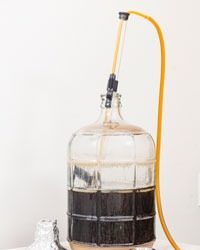The Ester Family
Esters . . . sometimes as a brewer you may be on the hunt to increase the esters in your final beer. You may want to coax more banana flavor from a Bavarian wheat strain of yeast, or more peach character from that Conan strain of yeast used in your New England IPA. Both of these characteristics fall into the ester family of compounds. Most esters in beer are yeast-derived compounds that are perceived as fruit-like or flower-like flavors/aromas. This may be perfect for some styles, but you don’t want banana or peach flavors in your Munich helles. So today let’s explore what esters are and how to control them in your beer.
It All Starts With Chemistry
Simply put, esters that we find in beer are a result of combining an acid molecule with an alcohol molecule. Esters are a huge class of compounds and the structure of esters can appear wildly different, some with rings, some single long chains, some with multiple branches. I’m hoping you’ve heard of polyesters? The classes of esters in beer are fairly volatile, meaning that when you drink a beer, they can more easily enter your nasal cavity to be smelled . . . just like hop oils. Once there, your olfactory senses can detect different ester classes in a huge array of descriptors . . . apple, pineapple, wintergreen, nail polish, lavender, cream, banana, honey, grape, cherry . . . the list goes on.
Controlling Esters — Yeast Selection
Yeast selection is going to be the main driving force controlling ester production in beer. The reason is that most esters are produced inside yeast cells. Esterification is the name of combining an acid molecule and an alcohol molecule to create an ester and is performed by yeast enzymes. Various yeast strains have been carefully selected over hundreds of years because they may be good at certain pathways, like Bavarian wheat strains of yeast are good at creating the banana-smelling isoamyl acetate by linking acetyl CoA and isoamyl alcohol. Other strains have been selected in a similar fashion because they are not good at performing this task, like Bavarian lager strains.
Controlling Esters — Fermentation Conditions
So the key drivers here are fermentation temperature and the pressure applied to the yeast in the wort. To step through these two factors, generally speaking, warmer fermentation temperatures promote more ester production. This is a generalization and some disparities have been known to occur. The vast majority of homebrewers don’t need to worry about fermentation pressure . . . only if you are fermenting under pressure. One of the recent crazes in the homebrew world is to use something called a spunding valve, attached to the vent port of a fermenter in order to allow fermentation to occur under pressure — this should only be done in vessels like Corny kegs or working pressure-rated unitanks. In general, the more head pressure in the fermentation vessel, the less ester formation. Open fermentations would be used to promote ester formation, like for an English bitter or Bavarian wheat. One important thing to note is that ale yeasts create most of their esters in the first 36 hours of active fermentation. Lager yeast can continue to create esters for weeks. So those are the timeframes you most want to focus on controlling temperature and pressure.
Controlling Esters — Wort Composition
The wort you present to the yeast will also affect ester production. Aeration/oxygenation levels, zinc availability, and something known as the beer’s FAN (free amino nitrogen) levels are the three most widely noted. When it comes to oxygenation levels, generally more oxygen leads to less ester production. Also, the addition of yeast nutrients with zinc will not only improve yeast performance, but the zinc has also shown to increase ester production. Finally the FAN level can also be manipulated to control ester formation. Using more low-nitrogen adjuncts, like corn or rice, can lower the ester formation in the beer.
One thing many more experienced homebrewers might be scratching their heads about is the omission of yeast pitch rate here. Typically homebrewers associate higher pitch rates with cleaner fermentations (less esters) and vice versa. But what multiple studies have shown is that there is not a clear-cut nor a linear correlation here. Sometimes overpitching can lead to increased ester levels, but so can underpitching in other situations. The key is to find a pitch rate that works for you and that strain in a recipe.
Some final thoughts: Just because one strain produces high levels of esters in one set of conditions, doesn’t mean another strain will mirror that. Also some esters can form spontaneously as well, but this pathway is much slower. This happens during long-term aging. Esters can also be broken down by enzymes called esterases. Esterases prefer certain classes of esters over others, so the ester composition will change over time as a beer ages. Some ester levels will slowly increase with aging beer while others go into decline.


